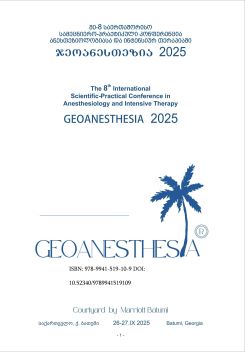INTRAOPERATIVE BLOOD PRESSURE MANAGEMENT
DOI:
https://doi.org/10.52340/9789941519109.12Keywords:
intraoperative hypotension, mean arterial pressure, anesthesia, organ protection, perioperative outcomes, blood pressure targetsAbstract
Background: Intraoperative blood pressure (BP) management is one of the cornerstones of anesthetic practice. Perioperative hypotension, particularly mean arterial pressure (MAP) below 60–65 mmHg, has been consistently associated with increased risk of myocardial injury, acute kidney injury, and mortality [1,2]. Despite advances in monitoring and pharmacologic support, the optimal intraoperative BP targets and management strategies remain an area of active discussion and research.
Objective: This presentation aims to review current evidence and international guidelines on intraoperative blood pressure management, highlight the pathophysiological rationale for specific thresholds, and discuss practical strategies applicable to different patient populations and surgical contexts.
Methods: A narrative review of recent guidelines (ESAIC, AHA/ACC, ASA perioperative recommendations) and key randomized controlled trials was conducted. Emphasis was placed on patient-centered outcomes, individualized BP targets, and the balance between hypotension prevention and risks of excessive vasopressor use.
Results:Evidence demonstrates that:
MAP <60 mmHg sustained for >5 minutes is strongly linked with major adverse cardiac and renal events [1,3].
Individualized targets based on baseline/preoperative BP may be superior to universal thresholds, particularly in hypertensive patients [4].
Automated closed-loop systems and advanced monitoring (e.g., continuous non-invasive arterial waveform analysis) show promise in maintaining stable BP and reducing variability [5].
Perioperative outcome trials suggest that proactive vasopressor administration guided by continuous monitoring is associated with reduced incidence of myocardial injury after non-cardiac surgery (MINS) [6].
Conclusion: Optimal intraoperative BP management requires balancing standardized safety thresholds (MAP ≥60–65 mmHg) with individualized targets tailored to each patient’s baseline characteristics and surgical risk. Future approaches will increasingly rely on advanced monitoring and automated control systems to minimize hypotensive episodes. In Georgia, as in many countries worldwide, surgeons often request very low “no-fly-zone” blood pressures to reduce bleeding. This practice underscores the need for anesthesiologists to advocate for guideline-based protocols while accommodating patient variability, ultimately improving perioperative outcomes.
References
Sessler DI, Khanna AK. Perioperative hypotension and adverse outcomes: a narrative review. Anesth Analg. 2018;126(6):1747-1758.
Wesselink EM et al. Intraoperative hypotension and the risk of postoperative complications: a systematic review. Br J Anaesth. 2018;121(4):706-721.
Salmasi V et al. Relationship between intraoperative hypotension, defined by either reduction from baseline or absolute thresholds, and acute kidney and myocardial injury after noncardiac surgery. Anesthesiology. 2017;126(1):47-65.
Futier E et al. Effect of individualized vs standard blood pressure management strategies on postoperative organ dysfunction among high-risk patients. JAMA. 2017;318(14):1346-1357.
Rinehart J, Cannesson M. Closed-loop systems for hemodynamic control: an evolving paradigm. Anesth Analg. 2020;130(5):1305-1318.
Devereaux PJ et al. Association between hypotension during surgery and postoperative myocardial injury. Anesthesiology. 2017;126(1):92-104.





